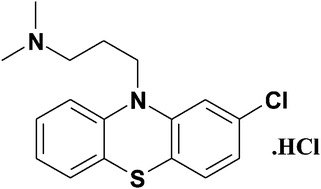Fabrication of chemically and in situ modified carbon paste electrodes for the potentiometric determination of chlorpromazine HCl in pure pharmaceutical preparations, urine and serum
Abstract
Newly developed modified and in situ modified carbon paste sensors were developed for the determination of chlorpromazine hydrochloride (CPZHC) in pharmaceutical formulations and biological fluids (urine and serum). The developed electrodes were characterized and optimized with respect to the main experimental parameters affecting the electrode performance including the composition, pH, temperature, response time, lifespan and interferences. The electrodes chemically modified with CPZ-TPB (electrode I) and CPZ-RN (electrode II) ion pairs exhibit a linear response over a concentration range of 1.0 × 10−6–1.0 × 10−2 mol L−1 with Nernstian slope values of 59.00 ± 1.75 and 55.50 ± 1.70 mV decade−1 at 25 °C over the pH range of 2–6 and 4–8, respectively. Meanwhile, in situ electrodes modified with NaTPB (electrode III), PTA (electrode IV) and RN (electrode V) ion pairing agents exhibited a linear response within the concentration ranges from 1.0 × 10−6 to 1.0 × 10−2, 1.0 × 10−6 to 1.0 × 10−2 and 1.0 × 10−7 to 1.0 × 10−2 mol L−1 with Nernstian slope values of 57.80 ± 0.37, 59.70 ± 0.88 and 59.57 ± 0.95 mV decade−1 at room temperature (25 °C) over the pH range of 2–6, 4–8 and 2–6, respectively. The dynamic response time of the modified electrodes was 7 s for a duration time of 53 and 35 days for electrodes (I) and (II), respectively. Meanwhile, the in situ modified electrodes had a fast dynamic response time of 11, 8 and 13 s for the duration time of 24, 42 and 58 days, respectively, for electrodes III, IV and V. The sensors were found to have good selectivity for CPZHC in the presence of some metal ions, sugars and glycine. Successfully, the developed sensors were used for the determination of CPZHC in neurazine tablets, urine and serum using calibration, potentiometric titration and standard addition methods. The obtained results were compared successfully with respect to those obtained using the official method. The proposed sensors showed significantly high selectivity, response time, accuracy, precision, limit of detection (LOD) and limit of quantification (LOQ) compared with other proposed methods, which confirmed the potential applicability of the developed method for the determination of CPZHC in real pharmaceutical tablets, serum and urine.



 Please wait while we load your content...
Please wait while we load your content...